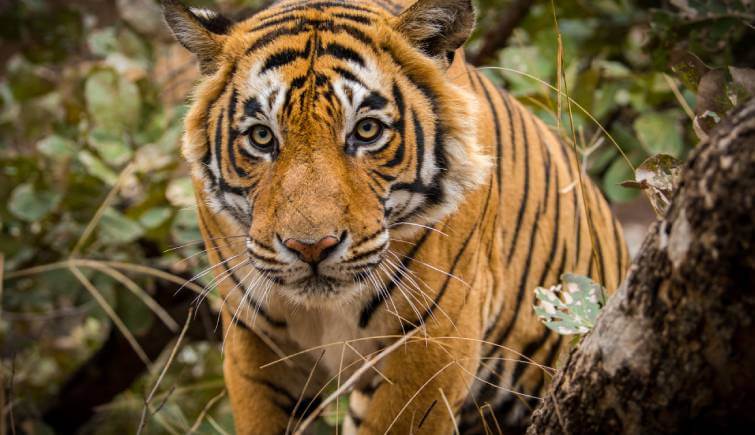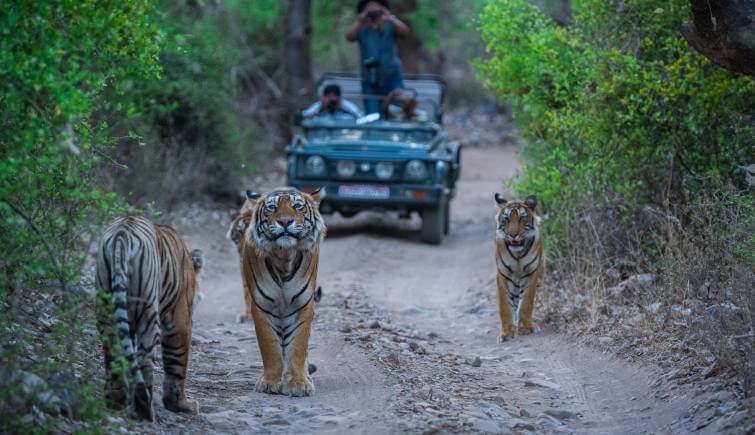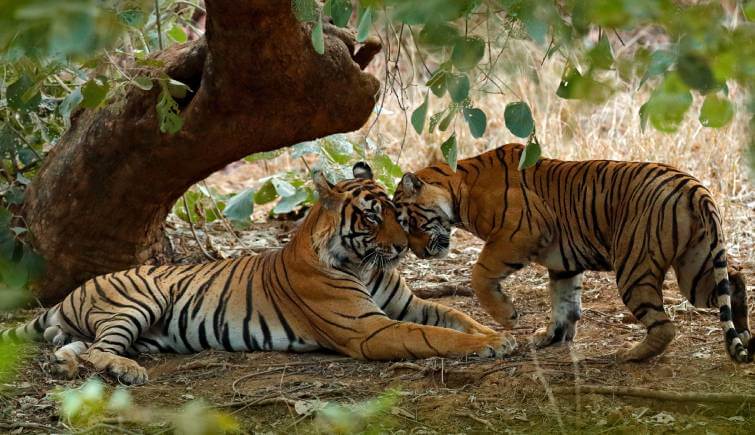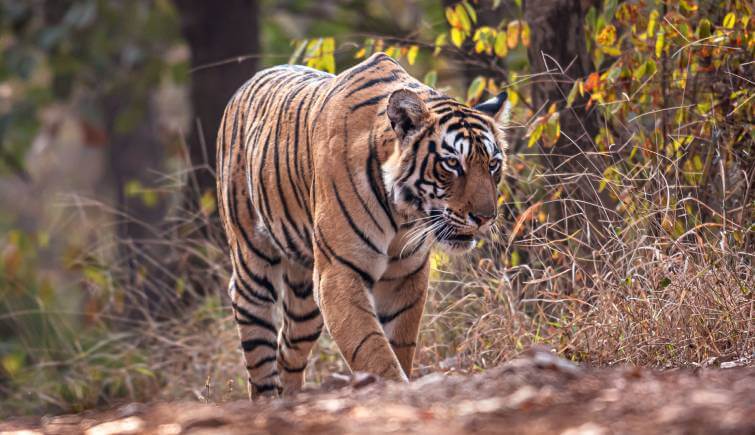
16 Feb, 2023
From Benefit to Threat: The Effects of Tourism on Tiger Conservation
Tigers are one of the most magnificent and iconic animals on the planet. They are an apex predator, symbolising power, strength, and grace. However, tigers are also one of the most endangered species in the world, with only around 3,900 individuals left in the wild. Despite significant conservation efforts, the primary threat to tigers remains habitat loss, poaching, and the illegal wildlife trade. Tourism has emerged as a potentially powerful tool for tiger conservation, which is now particularly referred to as ‘Tiger Tourism.’ But it also has the potential to create new challenges and risks. In this blog, we will examine the positive and negative impacts of tourism on tiger conservation.
Before that, let’s discuss a little bit about tiger tourism and tiger conservation in the world, as well as in India.
Everything You Need to Know About Tiger Tourism

Tiger tourism refers to the practice of visiting national parks and wildlife sanctuaries that are home to wild tigers, with the primary goal of observing and experiencing the majestic animal in its natural habitat. The main purpose of tiger tourism is to promote conservation efforts and raise awareness about the endangered status of tigers.
Tiger tourism activities can take many forms, ranging from guided jeep safaris and walking tours to elephant-back rides and boat trips. Visitors may also stay in accommodations located within or near the protected areas, such as lodges and campsites. During these activities, tourists can encounter tigers in the wild and observe their behaviour, movements, and interactions with other animals in their natural habitat.
Tiger tourism can provide a source of income for local communities, which can help incentivize them to support conservation efforts for protecting tigers and their natural habitat. However, it is important to ensure that effects of tiger tourism activities are conducted in a responsible and sustainable manner, to minimise any negative impacts on the environment and the tigers themselves.
Now, What is Tiger Conservation?

Tiger conservation is the set of efforts and strategies aimed at protecting wild tiger populations from the threats that endanger their survival. Tigers are considered to be one of the most iconic and charismatic species on the planet, but they are also one of the most endangered.
There are a number of threats to tiger populations, including habitat loss, poaching, and human-wildlife conflict. Tiger conservation efforts aim to address these threats and ensure that tiger populations can recover and thrive.
Some of the Key Components of Tiger Conservation Include:
 Habitat Protection and Restoration
Habitat Protection and Restoration
Tigers need large areas of forest to live and hunt, so protecting and restoring their habitat is crucial to their survival.
Anti-Poaching EffortsPoaching is a major threat to tiger populations, as their bones, skin, and other body parts are highly valued in some traditional medicines and as luxury goods. Anti-poaching efforts involve monitoring tiger populations and cracking down on illegal wildlife trade.
Conflict MitigationAs human populations grow and encroach on tiger habitat, conflicts between people and tigers can arise. Efforts to mitigate these conflicts can include measures such as relocating problem tigers or providing compensation to people who have lost livestock or crops to tigers.
Education and AwarenessRaising awareness about the importance of tiger conservation and the threats facing tiger populations is key to building support for conservation efforts.
Overall, tiger conservation is a complex and multi-faceted field that requires a range of strategies and approaches to be successful.
Let’s discuss about the importance of tourism for tiger conservation:
 Financial Benefits for Conservation Efforts
Financial Benefits for Conservation Efforts
Tourism provides a source of revenue that can be used to fund conservation efforts such as anti-poaching patrols, habitat restoration or protecting forests and community-based conservation initiatives. Revenue generated from tourism can also help support the local economy and reduce reliance on unsustainable practices such as hunting and deforestation.
Increased Awareness and EducationTourism provides an opportunity for people to learn about tigers and their conservation. It can also foster a sense of connection and empathy, which may inspire people to take action for protecting tigers and protecting jungles.
Sustainable EcotourismResponsible ecotourism can create incentives for the conservation of tiger habitats by encouraging sustainable land use practices, such as community-based conservation and wildlife-friendly agriculture. Ecotourism can also provide an alternative livelihood for local communities that would otherwise rely on destructive practices like logging, poaching, or mining.
Improved local conservation policiesTourism can generate political pressure for better policies and laws that protect tigers and their habitats. The international community can also apply pressure through boycotts or public pressure campaigns, as was the case with the boycott of tourism to Burma in the 1990s and early 2000s.
So, these are the positive impacts on tiger conservation. Now, the question comes, are there any negative impacts of tourism on tigers and other wildlife? The answer is yes. There are lots. Some of the important reasons are discussed below.
Negative Impacts of Tiger Tourism on Tiger Conservation:
 Disturbance to tiger behaviour
Disturbance to tiger behaviour
The presence of tourists can disrupt the natural behaviour of tigers, which may have negative consequences for their well-being. For example, tigers may spend more time hiding or avoiding tourist areas, which can affect their ability to hunt and mate. In some cases, the presence of tourists can also lead to aggressive behaviour towards humans or other animals.
Habitat destruction and fragmentationThe development of tourism infrastructure, such as roads, hotels, and trails, can lead to the fragmentation and degradation of tiger habitats. Habitat loss and fragmentation can increase the risk of inbreeding, reduce genetic diversity, and limit the availability of prey.
Increased poaching and illegal tradeTourism can also create opportunities for poachers and wildlife traffickers to operate. Tourists may unknowingly buy illegal wildlife products or participate in activities that are harmful to tigers, such as posing for photos with captive tigers or attending tiger shows. The demand for these activities and products can fuel poaching and the illegal wildlife trade.
Negative impacts on local communitiesTourism can create conflicts between tourists and local communities, particularly if the benefits of tourism are not equitably distributed. Local communities may also face environmental impacts such as pollution and habitat degradation, which can affect their livelihoods and well-being.
Tourism can be a powerful tool for tiger conservation, but it must be managed responsibly to ensure that it does not have negative impacts on tigers, their habitats, or local communities. The tiger and tourism debate can go on for centuries like that, but it is also important to remember that responsible ecotourism can provide a sustainable source of income for local communities while also promoting the conservation of tigers and their habitats. To maximise the positive impact of tourism on tiger conservation, it is important to work with local communities and stakeholders to develop and implement sustainable tourism practices that prioritise the long-term health of tigers and their habitats.
- Writer- Nandini
- Photo Credits: Shutter Stock
Frequently Asked Questions
What is the impact of tourism on tiger conservation?
There are positive as well as negative impacts of tourism on tiger conservation. Some of the positive impacts are financial benefits for conservation efforts, sustainable ecotourism, awareness of tiger conservation, whereas some of the negative impacts are disturbance of wildlife behaviour, habitat destruction, etc.
How does responsible tourism benefit tiger conservation?
Responsible tourism can create incentives for the conservation of tiger habitats by encouraging sustainable land use practices, such as community-based conservation and wildlife-friendly agriculture.
Can tourism generate funding for tiger conservation?
Tourism provides a source of revenue that can be used to fund conservation efforts such as anti-poaching patrols, habitat restoration or protecting forests and community-based conservation initiatives. Revenue generated from tourism can also help support the local economy and reduce reliance on unsustainable practices such as hunting and deforestation.
How does tourism affect the habitat of tigers?
The development of tourism infrastructure, such as roads, hotels, and trails, can lead to the fragmentation and degradation of tiger habitats. Habitat loss and fragmentation can increase the risk of inbreeding, reduce genetic diversity, and limit the availability of prey.
Does increased tourism result in the displacement of tigers?
Yes, increased tourism means more development which results in the development of roads, hotels and other related things. It degrades the natural habitat for tigers and other wildlife and displacement of tigers.
Can tourism lead to the destruction of tiger habitats?
Limited tourism does not affect the tiger habitats but increased limit of tiger tourism leads to the destruction of tiger habitats.
Does increased tourism lead to an increase in tiger poaching?
Tourism can also create opportunities for poachers and wildlife traffickers to operate. Tourists may unknowingly buy illegal wildlife products or participate in activities that are harmful to tigers, such as posing for photos with captive tigers or attending tiger shows.
Does increased tourism lead to an increase in human-tiger conflicts?
The presence of tourists can also lead to aggressive behaviour towards humans or other animals. Increased tourism can disrupt their lifestyle which leads to an increase in human-tiger conflicts.
How can responsible tourism practices be promoted to ensure the positive impact of tourism on tiger conservation?
Responsible tourism practices can play an important role in promoting the positive impact of tourism on tiger conservation. Encouraging tourists to participate in ecotourism activities can help promote responsible tourism practices that benefit tiger conservation. Tourism operators should follow tiger-friendly tourism practices that minimise disturbance to tigers, protect their habitat, and avoid direct contact with them. Tourists should be educated on tiger conservation and how their tourism activities can help or harm tiger populations. Tourists should be informed about responsible tourism practices and how they can contribute to tiger conservation. Overall, promoting responsible tourism practices that benefit tiger conservation requires a multi-stakeholder approach that involves tourists, tourism operators, local communities, and conservation organisations. By working together, we can ensure that tourism has a positive impact on tiger conservation and helps protect this iconic species for future generations.
Should the number of tourists be controlled to ensure the positive impact of tourism on tiger conservation?
Controlling the number of tourists can be one approach to ensure the positive impact of tourism on tiger conservation, but it may not be the only solution or the most effective one. Tourism can be an important source of income and employment for local communities, and it can help raise awareness and support for tiger conservation efforts. However, uncontrolled tourism can also have negative impacts on tiger habitats and populations, such as disturbing their natural behaviour, causing stress and disease, and damaging their habitat. Controlling the number of tourists can be one part of a larger strategy to ensure the positive impact of tourism on tiger conservation, but it should be considered in the context of broader efforts to promote responsible and sustainable tourism practices and address the underlying drivers of tiger habitat loss and poaching.
Explore Popular Ranthambore Wildlife Tour Packages
Other Interesting Blogs to Read- Information Trinetra Ganesh Temple Ranthambore
- Ranthambore National Parks Latest News Updates
- Best Luxury Resorts in Ranthambore National Park
- Peacock Flying in Ranthambore National Park
- Take a Jungle Safari at These 10 Best Wildlife Destinations in Summer Season & Get the Best of Wildlife Adventure
- The Inspiring Story of How Aditya & Poonam Singh Made a Lush Forest Out of a Barren Land in Ranthambore
- Why Should We be Teaching Wildlife Conservation in Schools?
- Do’s and Don’ts of Staying Safe Around Wildlife
- Human – Wildlife Conflict in Concrete Jungle
- 20 Facts You Probably Didn’t Knew About Tigers
- Wildlife Conservation Initiatives by Indian Government
- Experience Golden Triangle India with Ranthambore Tiger Safari
- 10 Reasons to Visit Ranthambore Tiger Reserve in Rajasthan
- In Pictures: Showcasing India’s Endangered Species
- My Experience at Ranthambore National Park- Sundeep Kheria
- Top 5 Star Hotels in Ranthambore Tiger Reserve
- Photography Tour in Ranthambore National Park
- Rajiv Gandhi Regional Museum of Natural History











 Share
Share Home
Home Packages
Packages Book Now
Book Now